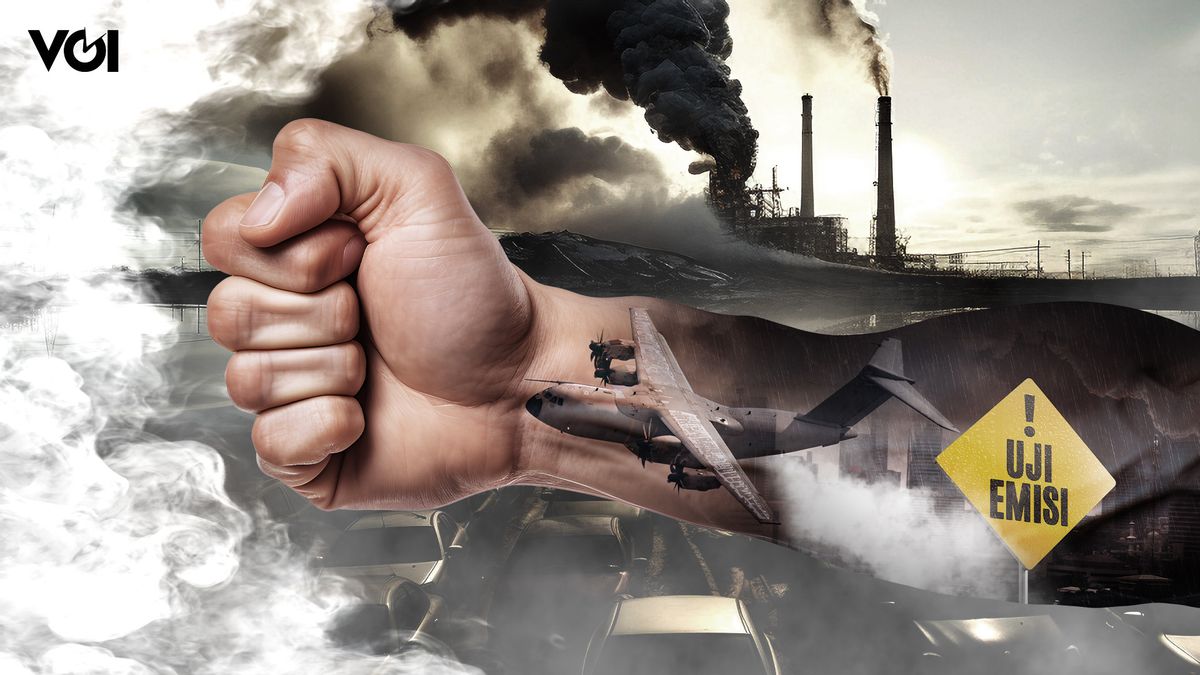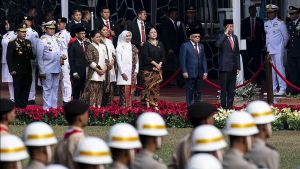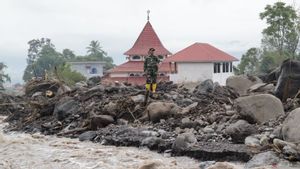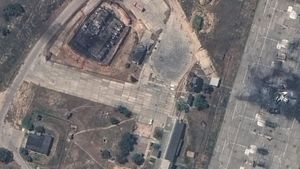
JAKARTA - Air pollution has become an familiar term in Jakarta. Bad air quality in the Indonesian capital threatens citizens of Jakarta and its surroundings. Air pollution consists of mixtures of dense particle complexes, liquid droplets, and gas derived from a variety of sources. Many factors account for air pollution, such as burning household fuels, industrial smoke, motor vehicle exhausts, power generation, and waste burning. Various sources produce different mixtures of air pollution. For example, in urban areas near the sea, particles can consist of sea salt, road dust, and diesel engine smoke. In rural areas near the forest, particles may consist of soil, stove smoke, or forest fires. Data from the World Health Organization (WHO) shows that 99 per cent of the world's population inhalates air with high pollutants or above the WHO guide limit. Bad air can cause cardiovascular and respiratory diseases, including stroke, lung cancer, and chronic obstructive pulmonary disease (PPOK).WHO, through Global Air Quality Guidelines (AQG), reveals a negative impact of air pollution on human health, even at low concentrations. Air pollution affects various aspects of health, and in 2021, WHO lowered almost all levels of AQG as a warning that exceeding this new limit is related to significant risk on health.WHO even estimates there are about seven million premature deaths each year due to exposure to air pollution, especially in low and medium opinion countries. In children, the effects include reduced lung growth, respiratory infection, and severe asthma. Among adults, ischemic heart disease and stroke are the main causes of early death due to outdoor air pollution. Bukti also suggests that air pollution can contribute to diabetes and neurodegenerative disruption. This impact suggests that disease burdens due to air pollution are equivalent to other global health risks, such as poor eating and smoking patterns.
The main source of Jakarta's Air Pollution In addition to climate change, air pollution has been identified as one of the biggest environmental threats to human health. The World Health Organization (WHO) emphasizes that improving air quality will help climate change mitigation efforts, and emission reduction will positively affect air quality. However, how is Jakarta in this context? Based on VOI monitoring on the IQAir page on Monday (28/8), Jakarta ranks The sixth is a city with poor air quality. This ranking is under Dhaka (Bangladesh), Kolkata (India), Dubai (UAE), New Delhi (India), and Karachi (Pakistan). Bad air quality in Jakarta was originally connected with the activities of 17 Steam Power Plants (PLTU) in West Java and Banten that use coal. However, the government denies this assumption by stating that air pollution in Jakarta mostly comes from motorized vehicle exhaust. According to him Minister of Environment and Forestry (LHK) Siti Nurbaya, the transportation sector contributed 44 percent of the use of fuel in Jakarta, followed by the energy industry with 31 percent, manufacturing with ten percent, the housing sector with 14 percent, and the commercial sector with one percent. In terms of carbon monoxide (CO) emissions, the transportation sector contributed the most, reaching 96.36 percent or around 28,317 tons per year, followed by power plants with 1.76 percent or about 5,252 tons per year, and industry with 1.25 percent or about 3,738 tons per year. Motorcycles are the main contributor to the high burden of pollution per passenger, beating private gasoline cars, diesel private cars, passenger cars, and buses. The motorcycle population reaches 78 percent of the total motorized vehicles in DKI Jakarta, totaling 24.5 million vehicles, with a growth of around 1,046,837 motorcycles per year. However, in terms of sulfur dioxide (SO2) emissions, The manufacturing industry sector is the largest contributor, reaching 2,631 tons per year or around 61.9 percent. The energy industry occupies the second position with 1,071 tons per year or around 25.17 percent. Meanwhile, motorized vehicles only contribute about eleven percent, or about 493 tons per year. Environmental Factors in Air Pollution in JakartaSiti Nurbaya, Minister of Environment and Forestry, dismissed the assumption that air pollution was caused by Steam Power Plants (PLTU) in Suralaya, Cilegon, Banten Province. The results of the analysis show that the air pollution from the PLTU does not move to Jakarta, but to the Sunda Strait. "Thus, pollution is not solely due to the PLTU. Studies show that the use of coal only affects less than one percent of Jakarta," he said. DKI Jakarta Environmental Service (LH) explains that meteorological factors also contribute to poor air quality in Jakarta, in addition to Jakarta increase in exhaust emissions. Asep Kuswanto, Head of the DKI Jakarta Environment Agency, explained that the concentration of air pollutants tends to increase during the dry season from May to August. However, during the rainy season from September to December, air quality tends to improve. PM2.5 concentration trend from 2019 to 2023 shows this. PM2.5 monthly average concentration increased from 29.75 g/m3 in April 2023 to 50.21 g/m3 in May 2023. However, this concentration is still still lower than May 2019 which reached 54.38 g/m3. Rainfall helps reduce air pollutants in the air, so that during the dry season the impact of pollution is reduced. How does the government deal with the problem of air pollution in Jakarta? Alue Dohong, Deputy Minister of Environment and Forestry, stated that the government has taken steps to overcome air pollution. Monitoring and patrols continue, as well as coordination in the field with weather monitoring, extinguishing, and patrols from the authorities. The program launched by the DKI Jakarta Provincial Government, such as the prohibition of parking for vehicles that do not pass the emission test, get support. Alue Dohong also encourages the public to support the transition program to electric vehicles and reduce the use of high-emissioned vehicles, including limiting the use of old vehicles. These steps are expected to work together to overcome the problem of air pollution in Jakarta.Learn from Beijing's Experience in Overcoming The Acting Air Pollution (Pj) of the Governor of DKI Jakarta, Heru Budi Hartono, is committed to following the steps taken by the Ministry of Environment and Forestry as well as related parties in overcoming the problem of air pollution in the capital city. Several programs have been implemented to deal with air pollution in Jakarta. This program involves Work from Home for State Civil Apparatus (ASN), tightening motor vehicle emission tests, tree planting, the use of electric vehicles, and modifications weather to create artificial rain in the Jabodetabek area. The DKI Jakarta Environmental Service recently required industrial companies with railroads to install a scrub and Continuous Air Quality Monitoring System (CAMS) to reduce air pollution in Jakarta. There are 14 industries that are required to comply with this provision. Steps both from the central government and the DKI Jakarta Provincial Government in overcoming air pollution deserve appreciation. The Indonesian government it it can also take inspiration from the experience of handling air pollution by the Beijing Government in China, which has succeeded in controlling the level of air pollution in its territory. During 2013 to 2017, Beijing managed to reduce emissions by up to 39 percent through the implementation of the Clean Air Action Plan (Clean Air Action Plan). Some policies taken in Beijing can be taken into consideration by the government to overcome air pollution in Jakarta: 1. Industrial Emission Reduction: Industry manufacturing is the main source of SOx emissions. The government must tighten emission control in this sector. Beijing has ended the operation of thousands of large-scale industries polluting the air. Production cuts for organic chemicals are also implemented. 2. Vehicle control: Beijing's measures to overcome air pollution also involve the transportation sector. These efforts include the removal of 2.1 million high-pollution vehicles and replacement with electric vehicles. Beijing Requires the installation of exhaust gas filtering devices on 7,600 heavy vehicles. Private vehicle restrictions are also implemented with the number of new vehicles limited to a certain year. 3. Relocation of Steam Power Plants (PLTU): The Beijing Government is directing attention on the power generation sector as a contributor to exhaust emissions such as CO2, SOx, NOx, and PM10 dust particles and PM2.5. For five years the PLTU was transferred. More than 24 thousand coal-fired vapor capacities were replaced with clean energy sources. The use of coal for heating and cooking is also prohibited for hundreds of thousands of households. The Indonesian government and DKI Jakarta can take valuable lessons from Beijing's experience in overcoming air pollution. These steps, if taken seriously, can have a positive impact on maintaining air quality and public health.
The English, Chinese, Japanese, Arabic, and French versions are automatically generated by the AI. So there may still be inaccuracies in translating, please always see Indonesian as our main language. (system supported by DigitalSiber.id)












